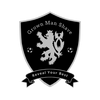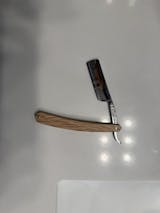The best shave isn't just about your razor's edge. It is also about maintaining your shaving products for years to come. A high-quality shaving brush is one of the best investments you can make for your wet shave routine. Whether you’re using a synthetic shaving brush, badger, boar, or horse hair, simple cleaning can prolong the life of your favorite shaving brush.
Did you know that most anthrax outbreaks in WWI were linked to dirty shaving brushes?
Shaving brushes are constantly in contact with water, shaving soap, shaving cream, and other shaving products when wet shaving. There may be problems and grim substances lurking underneath those bristles. Lather and shaving debris, like oil, hair, and dead skin, can also build up over time on your shaving brush. Not to mention tap water is no friend to your trusted shaving brush either. Over time, the minerals in tap water can eventually harden and make cleaning even more challenging.
Have no fear. We have come a long way since World War I. However, learning how to clean and store shaving brushes properly extends their life and keeps them hygienic. We wouldn't let any grown man lather up with a dirty brush, so we are here to show you exactly how to clean a shaving brush and store it properly.

The Basic Anatomy Of Shaving Brushes
Shaving brushes have a long history, and in all its anatomy, is the workhorse for creating a rich, luxurious thick lather from shaving soap or shaving cream and is the key to the best shave possible. It has two principal parts—the handle and the bristles, and a few other shaving brush parts you should get to know:
- Handle - the part you grip and the base that holds the knot, usually made of wood, horn, resin, plastic, and metal.
- Knot - the hairs or the topmost part of a shaving brush, often from animal hair and synthetic fibers.
- Knot Size - the knot’s diameter measured in millimeters, with standard sizes of 20-28mm.
- Glue Bump - the area often hiding within the handle that holds the bristles of the knot.
- Knot Loft - the height of the brush hair from the top of the knot to where it meets the handle.
- Splay - defines the coverage of your brush when the hair is pushed onto a surface, like your face, and spreads out.
- Back Bone - the resistance the brush makes while splaying.
- Scritch - the roughness or texture of the hairs as you lather on the face.
How Often Should You Deep Clean A Shaving Brush?
Several factors can affect your shaving brush's health and hygiene, quality, and effectiveness. Some of these include the hardness of your water, your shaving routine and schedule, and the kind of shave soap you use. One of the telltale signs that your brush needs a deeper cleaning is a white matte build-up on your bristles or near the knot.
Your home is no different than the the shaving shop. Always clean as soon as signs of lather build-up appear, when your brush doesn’t splay as well as before, and there are changes in its scritch or the texture of the bristles. However, the most practical rule regarding how often your trusted new badger brush or synthetic brush should be washed is to give it a deep clean before its first use and a deeper clean once a month at least to prevent hard-to-remove residues.
Deep cleaning before the first use is essential, especially for natural shave brushes, to remove unpleasant smells from substances used to treat animal hair. It is also necessary to wash a synthetic shave brush straight out of the box to remove chemical remnants from the manufacturing process.

How To Clean A Natural And Synthetic Shaving Brush
Washing a shaving brush is an easy yet delicate process. Utmost care is a must to ensure that you do not break the glue bump and change the texture and splay of the brush while still being able to draw out all the filth.
You can do a quick wash or deep clean with pet shampoo, diluted vinegar, borax, and liquid dish soap. Most shaving brushes are sensitive to harsh detergents. Follow these steps to properly clean your shaving brush.
Here is the proper way to clean a shaving brush in 6 simple steps:
- Pre-rinse your brush under tap water or using lukewarm water, gently massage, and rinse until the water runs clear.
- Put one to two drops of your shampoo or soap of choice in your palm, or prepare a very diluted solution of water and vinegar in your shaving mug or scuttle.
- Lather vigorously on your palm using your brush or in your bowl and use a pumping motion to get deep into the base of the bristles.
- Shake off the excess lather and soak your brush in warm water for 1-2 minutes.
- Wash and rinse the brush using clean water to remove any vinegar residue or soap residue, and gently squeeze the knots to remove excess water.
- Splay the brush over a soft dry towel or stand and allow it to air dry thoroughly for at least 24-48 hours until completely dry.
The most important thing to remember is to rinse your shave brush thoroughly after cleaning and not to flick it to remove excess water. Gently squeezing it with the slightest pressure and always air dry thoroughly with its knot side down.
Best Cleaning Items For Shaving Brushes
Animal hair products and mild cleaning agents are the best for washing a shaving brush. It does not matter if your knots are made of synthetic fibers, as it mimics the texture of animal hair. Listed below are the best cleaning items for shaving brushes and how to use them:
Shampoo
For those using a brush with natural knots, like a badger brush, pet shampoos have excellent ingredients that can clean your brush’s bristles. If you do not have pets but have kids, you can use baby shampoo or any mild shampoo—whichever is more convenient.
To clean your shave brush with shampoo, start by wetting the brush under running water. Then, put one to two drops of shampoo on your palm and lather vigorously on a damp brush to break up hardened residue. Rinse and dry accordingly.
Diluted Distilled White Vinegar
White vinegar is an excellent disinfectant thanks to its acidic nature. It is your best comrade in disintegrating the soap scum off your shaving brush while killing bacteria.
Use it to cleanse your brush by creating a very diluted vinegar solution. Mix one part of distilled white vinegar with nine parts of hot water. The mixture should be in a clean container, with the water not too hot to avoid damaging your brush knots.
After soap-washing your brush, soak it in the vinegar mix; knot side down with the solution reaching the base of the bristles. Leave it for 10 minutes while occasionally mixing to soften hardened lather residues.
If there is still visible soap scum or dirt, you can use an old toothbrush to brush them off gently. After, rinse the brush thoroughly in running water and dry as directed above.
A Few Drops Of Mild Liquid Dishwashing Soap Or Laundry Boosters (Borax)
Dishwashing soaps and borax are great for getting rid of dirt, grime, and grease. It also has excellent disinfecting properties while being mildly scented.
Using a liquid dishwashing soap or borax to wash a shaving brush is similar to diluted white vinegar:
- Put one to two drops of soap into a container full of water—just enough to reach the base of the brush knot.
- After washing the brush with clean tap water, soak its bristles in the solution while mixing occasionally.
- Remove visible residues by brushing them towards the tips using a toothbrush, then dry them properly.

The Dos And Dont's For Maintaining Your Shaving Brush
Most men get into traditional wet shaving due to its practicality, which is why each tool is made to last. On that note, shaving brushes can be a long-time investment that can stay with you for years—only if taken care of properly.
Extend its usefulness and maintain its quality by following the dos and don’ts of caring for a shaving brush:
Be gentle
Men do love vigor, but not your shaving brush. More pressure when lathering (and cleaning) does not mean you can get the job done better. Your shave brush needs to be handled with care to prevent it from losing hair or changing in splay.
Dry naturally
Avoid using hair dryers to hack your way out of the drying process, and never squeeze the life out of your knots! Instead, leave it to air dry naturally.
Clean regularly
Clean your brush regularly from soap residue. Leaving it unattended for a long while or using it straight out of the box may transfer some bacteria to your skin, leading to shaving irritations and allergic reactions later on.
Do not use boiling water
Hair is very susceptible to heat as it could change the shape of the hair strands. Use warm water, not boiling, to clean your brush. This will be enough to break down the grime build-up on your knots.
Do not flick to dry
Wet brush knots are denser and heavier. Doing the traditional flick-to-dry method could strain the glue bump, causing it to loosen up.
Tips For Cleaning Specific Shaving Brushes
Although you can use the same cleaning solutions and methods for both natural and synthetic shaving brushes, you will still need some precautions in handling specific grades of shaving brushes.
Synthetic fiber brush and silvertip badger brush are similar in texture. They provide less scritch and are softer and more delicate on the face. Meanwhile, pure and super badger brushes are on the coarser side, with better water retention properties.
Cleaning pure and super badger brush
Pure badger brush and super badger brush hold more water and have the stiffest bristles. They also have the funkiest smell. The best way to clean natural brushes is to lather and rinse them a few times until there is no distinct smell. Then, proceed with a deep clean with a vinegar solution and dry properly.
Cleaning silvertip badger brush and synthetic fiber brush
These brushes have softer bristles and need more care. Follow the proper brush cleaning process while mildly and gently handling the knots. Then, air dry it properly.
The Shaving Brush Ritual Post Shave
There is no need to wait a month or half a year to wash your shave brush. You can do it every wet shave. Make it a habit as part of your post-shave process.
Here’s how:
- Use warm water to rinse excess lather after shaving.
- Splay the brush in a clean, soft towel to remove excess water.
- Prompt the brush in a shaving brush stand with the bristles pointing downwards to draw out moisture away from the base and glue bump.
- Place your brush stand in an open space with excellent air circulation.
- Clean your shaving scuttle or bowl thoroughly to remove the residual foam.
- Remember not to pull or tug the bristles and use a hair dryer to dry a shaver’s brush.
Proper Storage Of Shaving Brush
Tidying up your shaving gear collection after a good shave is an empirical rule to maintain them in tip-top condition. Do not leave your shaving brush to dry in a scuttle or leave it base-side down on the countertop.
Properly store a shaver’s brush using a shaving brush stand and place it in an open and well-ventilated area. Placing a wet brush or a seemingly dry brush inside the closet promotes mildew and mold growth and defeats the rigorous cleaning process.
Take these pointers to heart and give your brush its needed TLC. You will save on future expenses and headaches for the years to come.















